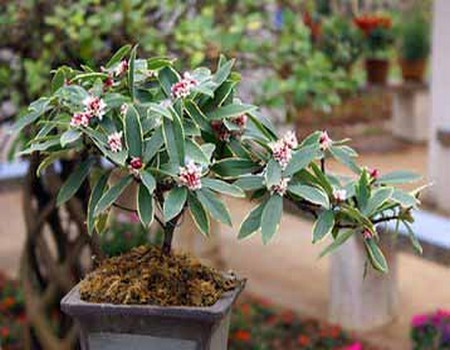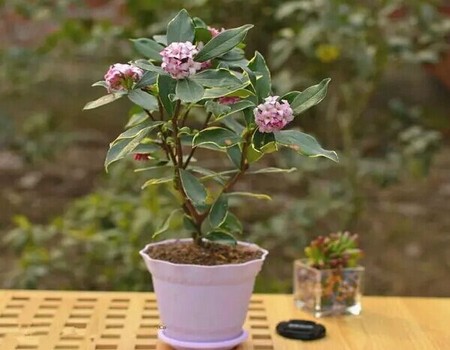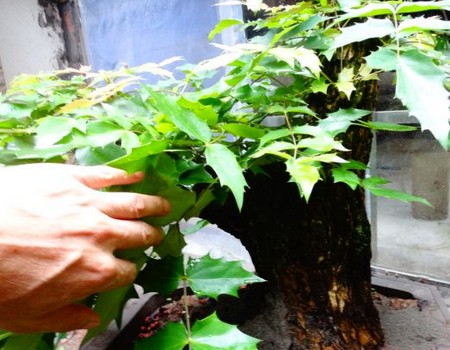Maintenance method of Daphne odora bonsai in Phnom Penh
Daphne odorifera from Phnom Penh is known as the "king of fragrant flowers" and one of the three treasures of Chinese art, with high ornamental value and medicinal value. Through summer pruning and other measures, Phnom Penh Daphne can make the first batch of flowers bloom in late January and fade at the end of February; the second batch of flowers begin to bloom at the end of February and blossom in early April, and the flowering period is more than two months, which is about twice longer than that of conventional cultivation.

Phnom Penh Daphne adapts to warm climate, but is not resistant to strong light and likes semi-shade; its root is fleshy, resistant to dry and damp, and is prone to mosaic disease in high temperature and humidity season. Bordeaux solution can be sprayed 2-3 times before the arrival of high temperature and humidity season.
At ordinary times, we should pay attention to observe the leaves of Phnom Penh Daphne. If the leaves are straight and straight up, it means that the fertilizer is normal; if the leaves are sagging, it is due to too much fertilizer, too often, or too much watering, so we should find out the reasons and take corresponding measures. Watering too much, easy to correct, if the fertilizer is not used properly, you can continuously pour water, let the fertilizer run off from the basin, and then put it in a ventilated place to make the basin soil dry quickly. If you have rotten roots, you need to turn the basin, cut off the rotten roots, wash them with fungicides, and then plant them in the sand to let them grow new roots. The upper branches and leaves should also be cut off accordingly.
Phnom Penh Daphne was watered once when the bud was about to sprout at the beginning of spring, and then poured thoroughly after the basin soil was dry. In summer, in addition to keeping the basin soil dry and wet alternately, it is also necessary to spray water around it and leaves regularly to cool down. The basin soil is in a semi-dry state at the end of autumn, which slows down the growth potential and is beneficial to overwintering.
Apply thin fertilizer frequently after the beginning of autumn until the buds bloom. Fertilizer and water dominated by nitrogen and potassium are applied in spring, and phosphorus is mainly applied after autumn. After the formation of flower buds, potassium dihydrogen phosphate with a concentration of 0.1-0.2% can be used to spray branches and leaves for external fertilization, but fertilizer and water must be sprayed on the back of leaves to improve fertilizer efficiency and promote flowers and leaves to flourish. Phnom Penh Ruixiang avoid using human feces and urine fertilizer.
Taking advantage of the pruning resistance and strong top dominance of Phnom Penh Daphne odora, the pruning method was adopted to promote sprouting. From June to July, part of the new shoots or new shoots of the same year were cut off in batches (the cut branches can be used for water or soil cutting) to promote the lateral buds under the cutting mouth to germinate new branches. After the beginning of autumn, Phnom Penh Daphne carried out flower bud differentiation and bud gestation, the uncut spring shoots stopped growing long ago, and flower bud differentiation and budding were carried out after autumn, while the summer shoots germinated after pruning did not stop growing in early autumn, the flower bud differentiation was slightly later, thus prolonging the flowering period.
Stop root fertilization from July to August, but can be combined with watering or foliar spraying 0.3% potassium dihydrogen phosphate solution 2-3 times to make branches strong and leaves thick; at the beginning of September, potassium dihydrogen phosphate solution was applied every 10 days to promote flower bud differentiation and bud pregnancy; 0.3% potassium dihydrogen phosphate solution was sprayed once a month in winter to improve plant cold resistance, promote early flowering, and promote large flowers, gorgeous flowers and long flowering period. Stop fertilizing after blooming.
Watering should be based on the principle of seeing dry and wet. Especially when the summer temperature is high, the air is dry, and Phnom Penh Daphne is in a semi-dormant state, it is necessary to make the pot soil slightly dry. But the relative humidity of the air needs to be slightly higher, so foliar spray water is needed once or twice a day, and sprinkle water around to humidify. Less watering during the Mid-Autumn Festival stops the growth of summer shoots and promotes flower bud differentiation.
At the same time, we should pay attention to giving reasonable lighting and ventilation conditions, do a good job in overwintering management and pest control, and do not move flowerpots during flowering.
Note:
1. The selection of cultivated soil: choose the soil rich in humus with good drainage and water retention. This kind of soil can dig the surface rotten leaf soil directly from the mountain forest region and mix it with a small amount of river sand and mature cake fertilizer, or choose vegetable garden soil to add part of rotten leaf soil, a small amount of river sand and rotten cake fertilizer.
2. The choice of environment for placing potted flowers: Phnom Penh Daphne is a kind of plant that likes cool and ventilated environment. From June to October, potted flowers should be placed in a cool place from 9 a.m. to 4 p.m. Or take the method of setting up a shed to solve the problem.
3. Water management: the soil must be kept moist in summer and autumn, rather wet than dry, in order to ensure the water supply of the plant.
4. Pruning in time: the plants with exuberant growth and numerous branches and leaves in spring are treated with heart-picking and leaf-picking, and too many new sprouting branches are removed to control the evaporation of water too quickly.
5. Treatment of diseased plants: once Phnom Penh Daphne occurs, the diseased plants should be disposed of immediately with pot soil, and flowerpots should be washed and disinfected. Other uninfected strains were washed and disinfected with 500-fold carbendazim to prevent the spread of the disease.
Time: 2019-06-01 Click:
- Prev

Culture methods and matters needing attention of potted Phnom Penh Daphne
Phnom Penh Daphne, alias Ruixiang, sleeping incense, dew nail, Penglai flowers, amorous trees, Ruixiang plants, is a traditional Chinese famous flower, but also a world famous flower. Like Phnom Penh Daphne, it usually blossoms during the Spring Festival, with a florescence of more than 60 days. It is free and easy in posture, curved and natural, with neat and verdant leaves, yellow like gold and jade like jade.
- Next

Maintenance and management methods of broad-leaf bonsai
The name "ten meritorious works" does not sound like the name of a plant at all, but it happens to be a kind of plant, and because it can be used not only to medically treat a variety of diseases, but also to embellish and beautify the environment, so it has high economic value.
Related
- Fuxing push coffee new agricultural production and marketing class: lack of small-scale processing plants
- Jujube rice field leisure farm deep ploughing Yilan for five years to create a space for organic food and play
- Nongyu Farm-A trial of organic papaya for brave women with advanced technology
- Four points for attention in the prevention and control of diseases and insect pests of edible fungi
- How to add nutrient solution to Edible Fungi
- Is there any good way to control edible fungus mites?
- Open Inoculation Technology of Edible Fungi
- Is there any clever way to use fertilizer for edible fungus in winter?
- What agents are used to kill the pathogens of edible fungi in the mushroom shed?
- Rapid drying of Edible Fungi

